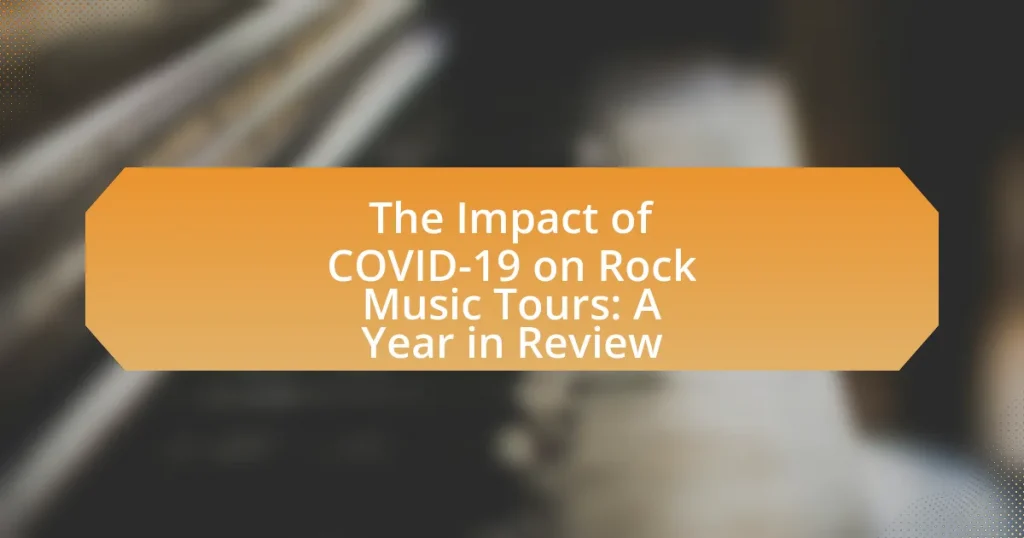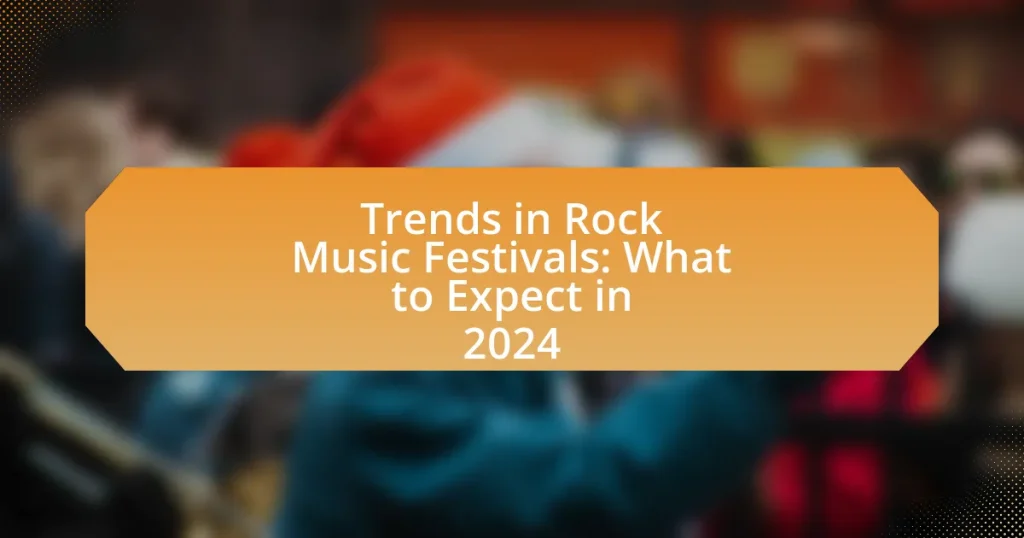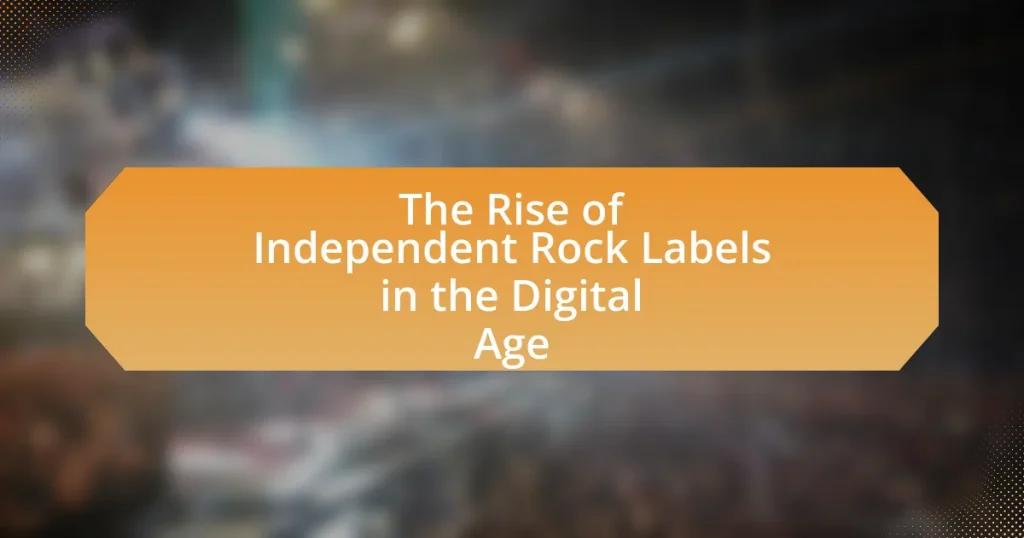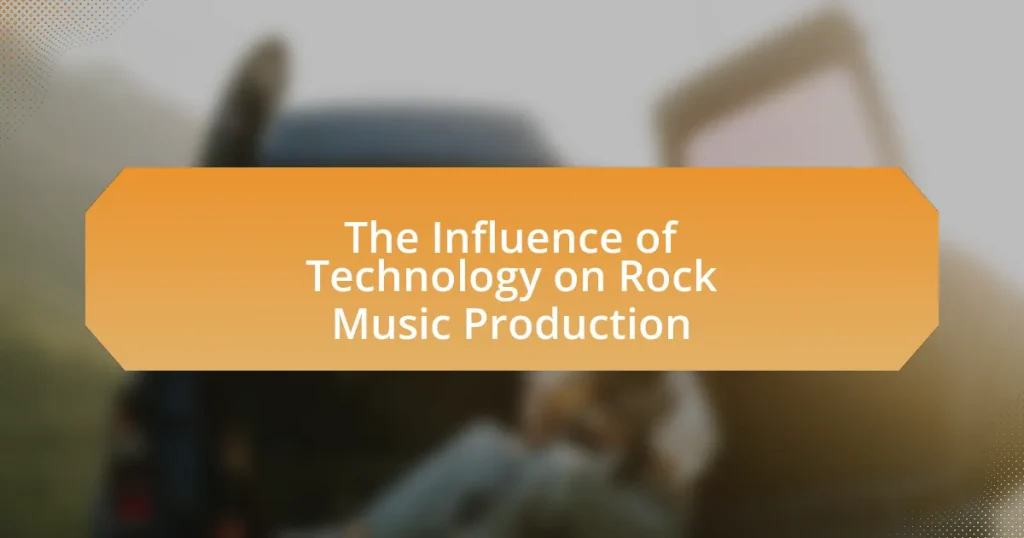The article examines the significant impact of COVID-19 on rock music tours, highlighting the extensive cancellations and postponements that led to an estimated $30 billion loss in the live music industry in 2020. It details the immediate effects on major festivals and artists, the shift towards virtual performances, and the long-term changes in touring practices, including enhanced health protocols and hybrid concert formats. Additionally, the article discusses the economic repercussions for artists and venues, the evolution of audience behavior, and the innovative strategies employed by musicians to maintain fan engagement during the pandemic. It concludes with insights on future implications for the rock music touring landscape post-COVID-19.

What is the Impact of COVID-19 on Rock Music Tours?
The impact of COVID-19 on rock music tours has been profound, leading to widespread cancellations and postponements of events. In 2020, the live music industry faced a loss of approximately $30 billion in revenue due to the pandemic, as major tours were halted and venues closed. Artists and promoters were forced to adapt by exploring virtual concerts and alternative revenue streams, but the overall disruption significantly affected fan engagement and artist income. The pandemic also prompted a reevaluation of health protocols and safety measures for future tours, reshaping the landscape of live music events.
How did the pandemic initially affect rock music tours?
The pandemic initially halted rock music tours worldwide, leading to widespread cancellations and postponements. In March 2020, major festivals and concerts were canceled, including Coachella and Glastonbury, due to health concerns and government restrictions on gatherings. This disruption resulted in significant financial losses for artists, promoters, and venues, with the live music industry facing an estimated $9 billion revenue loss in 2020 according to the National Independent Venue Association.
What were the immediate cancellations and postponements of tours?
The immediate cancellations and postponements of tours due to COVID-19 included major events such as the Coachella Valley Music and Arts Festival and the Glastonbury Festival, both of which were canceled in 2020. Additionally, numerous artists, including Taylor Swift and Pearl Jam, postponed their tours, with Swift’s “Lover Fest” and Pearl Jam’s North American tour being significant examples. These cancellations and postponements were largely driven by health concerns and government restrictions aimed at curbing the spread of the virus, leading to widespread disruption in the live music industry.
How did artists and promoters respond to the crisis?
Artists and promoters responded to the crisis by pivoting to virtual performances and rethinking their touring strategies. Many artists began hosting live-streamed concerts to maintain engagement with fans, while promoters adapted by creating flexible ticketing options and rescheduling events to accommodate health guidelines. For instance, in 2020, major artists like Pearl Jam and Billie Eilish utilized platforms like Instagram Live and YouTube to reach audiences, demonstrating a shift towards digital engagement. Additionally, promoters implemented safety protocols for in-person events, such as reduced capacity and social distancing measures, to ensure compliance with health regulations.
What long-term changes have emerged in the rock music touring industry?
The rock music touring industry has experienced significant long-term changes, primarily driven by the COVID-19 pandemic. These changes include a shift towards more flexible ticketing options, increased emphasis on health and safety protocols, and a greater reliance on digital platforms for promotion and fan engagement. For instance, many artists now offer options for fans to purchase tickets that can be refunded or exchanged in case of cancellations, reflecting a need for consumer protection in uncertain times. Additionally, venues have implemented enhanced sanitation measures and social distancing guidelines to ensure audience safety, which has become a standard expectation. Furthermore, the rise of live-streaming concerts during the pandemic has led to a hybrid model of touring, where artists combine in-person shows with virtual experiences to reach wider audiences. This evolution indicates a lasting transformation in how rock music tours are organized and experienced.
How has audience behavior shifted due to COVID-19?
Audience behavior has shifted significantly due to COVID-19, with a marked increase in virtual engagement and a decline in live attendance at events. During the pandemic, many audiences turned to online platforms for concerts and music experiences, leading to a 50% increase in virtual event attendance compared to pre-pandemic levels. Additionally, concerns over health and safety have resulted in a 70% decrease in in-person attendance at live music events, as audiences prioritize safety and social distancing measures. This shift highlights a transformation in how audiences consume music, favoring digital experiences over traditional live performances.
What new safety protocols have been implemented at concerts?
New safety protocols implemented at concerts include mandatory health screenings, social distancing measures, and enhanced sanitation practices. Health screenings often involve temperature checks and health questionnaires to identify potential COVID-19 symptoms among attendees. Social distancing measures require seating arrangements that maintain physical distance between groups, while enhanced sanitation practices involve frequent cleaning of high-touch surfaces and availability of hand sanitizers throughout the venue. These protocols aim to minimize the risk of virus transmission and ensure the safety of both attendees and staff during events.
What economic impacts did COVID-19 have on rock music tours?
COVID-19 significantly disrupted rock music tours, leading to an estimated loss of $30 billion in the live music industry in 2020 alone. The pandemic resulted in widespread cancellations and postponements of concerts, with over 90% of live events being affected globally. This decline in live performances not only impacted artists and promoters but also led to job losses for thousands of workers in the industry, including crew members, venue staff, and vendors. Additionally, the economic ripple effects extended to local economies that rely on tourism and hospitality associated with music events, further exacerbating the financial strain caused by the pandemic.
How did the pandemic affect ticket sales and revenue for artists?
The pandemic significantly decreased ticket sales and revenue for artists, with live music events being canceled or postponed globally. According to a report by Pollstar, the live music industry lost approximately $30 billion in 2020 due to COVID-19 restrictions, leading to a dramatic decline in income for artists who rely on touring as a primary revenue source. Additionally, a survey conducted by the Music Industry Research Association found that 90% of musicians reported a loss of income during the pandemic, highlighting the severe financial impact on artists across various genres.
What financial support measures were available for the music industry?
Financial support measures available for the music industry during the COVID-19 pandemic included government grants, loans, and relief funds specifically aimed at artists and venues. For instance, in the United States, the Shuttered Venue Operators Grant provided financial assistance to eligible venues affected by the pandemic, while the Paycheck Protection Program offered forgivable loans to help businesses retain employees. Additionally, various countries implemented similar initiatives, such as the UK’s Culture Recovery Fund, which allocated £1.57 billion to support cultural organizations, including those in the music sector. These measures were crucial in mitigating the financial impact of the pandemic on the music industry.
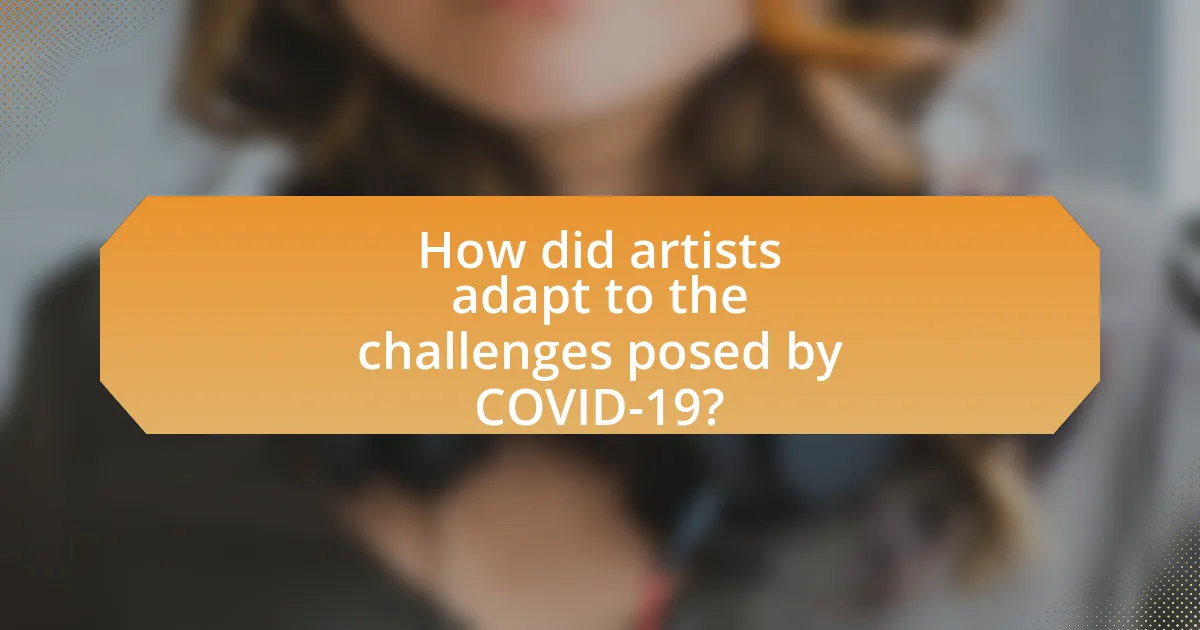
How did artists adapt to the challenges posed by COVID-19?
Artists adapted to the challenges posed by COVID-19 by shifting to virtual performances and leveraging digital platforms for engagement. Many musicians conducted live-streamed concerts on platforms like Instagram, Facebook, and YouTube, allowing them to reach audiences despite physical distancing measures. For instance, the “Together at Home” concert series, initiated by Global Citizen, featured numerous artists performing from their homes, raising over $127 million for COVID-19 relief efforts. Additionally, artists began selling merchandise online and offering exclusive content through subscription services, which helped sustain their income during a time when live events were largely canceled. This transition to digital formats not only maintained audience connection but also opened new revenue streams, demonstrating resilience and innovation in the face of unprecedented challenges.
What innovative strategies did musicians use to connect with fans?
Musicians employed live streaming concerts as an innovative strategy to connect with fans during the COVID-19 pandemic. This approach allowed artists to perform in real-time from their homes or studios, reaching global audiences without the constraints of physical venues. For instance, platforms like Instagram Live and YouTube became popular for hosting virtual performances, enabling artists to interact with fans through comments and live chats. Additionally, musicians utilized social media to share behind-the-scenes content and personal stories, fostering a sense of intimacy and community. This shift not only maintained fan engagement but also opened new revenue streams through virtual ticket sales and merchandise.
How did virtual concerts change the landscape of live music?
Virtual concerts significantly transformed the landscape of live music by providing artists with a platform to reach global audiences despite physical venue restrictions. During the COVID-19 pandemic, traditional live performances were largely halted, leading to a surge in virtual events, which allowed musicians to maintain engagement with fans and generate revenue through ticket sales and merchandise. For instance, platforms like Twitch and YouTube Live hosted numerous virtual concerts, with some events attracting millions of viewers, such as Travis Scott’s Fortnite concert, which drew over 12 million participants. This shift not only democratized access to live music but also encouraged innovation in performance formats, blending gaming, visual art, and interactive experiences, thereby reshaping audience expectations and artist-fan interactions in the music industry.
What role did social media play in promoting music during the pandemic?
Social media played a crucial role in promoting music during the pandemic by providing artists with platforms to connect directly with their audiences. As live performances were largely canceled, musicians utilized social media channels like Instagram, Facebook, and TikTok to share live-streamed concerts, engage with fans through Q&A sessions, and release new music. For instance, a study by the International Federation of the Phonographic Industry (IFPI) reported that 70% of music fans discovered new music through social media during this period. This shift not only maintained fan engagement but also allowed artists to reach wider audiences globally, compensating for the lack of physical tours.
How did collaborations and partnerships evolve during this period?
Collaborations and partnerships in the rock music industry evolved significantly during the COVID-19 pandemic as artists sought innovative ways to connect with audiences and support each other. Many musicians turned to virtual collaborations, utilizing digital platforms to create music together remotely, which allowed for cross-genre partnerships that may not have occurred in a traditional setting. For instance, artists like Billie Eilish and Finneas collaborated with various musicians through online sessions, resulting in unique blends of styles and increased visibility for lesser-known artists. Additionally, partnerships with streaming services became crucial, as platforms like Spotify and YouTube facilitated live-streamed concerts and virtual festivals, enabling artists to reach global audiences despite physical tour restrictions. This shift not only maintained fan engagement but also fostered a sense of community among artists during a challenging time.
What unique projects emerged from artist collaborations during COVID-19?
Unique projects that emerged from artist collaborations during COVID-19 include virtual concerts, collaborative online albums, and social media-driven art initiatives. For instance, the “Together at Home” concert series, organized by Global Citizen and featuring artists like Chris Martin and Billie Eilish, provided live performances from home to raise funds for COVID-19 relief. Additionally, the album “Songs for the COVID-19 Era,” which included contributions from various artists, showcased collaborative efforts to address the pandemic’s impact through music. These projects not only engaged audiences during lockdowns but also highlighted the adaptability and creativity of artists in response to unprecedented challenges.
How did partnerships with streaming platforms impact music distribution?
Partnerships with streaming platforms significantly transformed music distribution by providing artists with direct access to global audiences and enabling real-time data analytics. These collaborations allowed musicians to release music more frequently and efficiently, bypassing traditional distribution channels. For instance, in 2020, Spotify reported over 50 million tracks available on its platform, illustrating the vast reach artists gained through such partnerships. Additionally, the COVID-19 pandemic accelerated the shift towards digital consumption, with streaming services seeing a 20% increase in usage during lockdowns, further solidifying their role in music distribution.
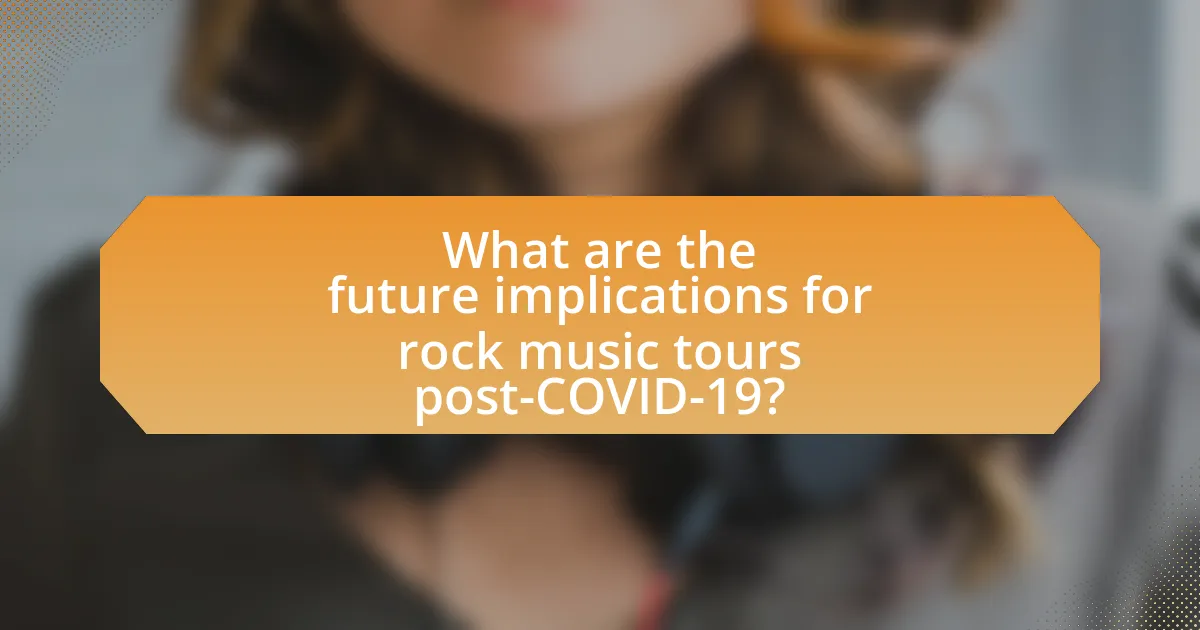
What are the future implications for rock music tours post-COVID-19?
The future implications for rock music tours post-COVID-19 include increased health and safety protocols, a shift towards hybrid concert formats, and potential changes in audience demographics. Health and safety measures, such as vaccination requirements and social distancing, are likely to remain in place to ensure the safety of both artists and fans. Additionally, the rise of virtual concerts during the pandemic has led to a trend where artists may incorporate online elements into their live shows, allowing for broader audience reach and engagement. Furthermore, the economic impact of the pandemic may alter audience demographics, with younger fans potentially becoming more prominent as they adapt to new concert experiences. These implications are supported by industry reports indicating a lasting change in concert formats and audience expectations following the pandemic.
How will the touring landscape look in the coming years?
The touring landscape in the coming years will likely see a significant shift towards hybrid models that combine live performances with virtual experiences. This evolution is driven by the lasting impact of COVID-19, which has accelerated the adoption of digital platforms for music consumption. According to a report by the International Music Summit, 75% of artists are expected to incorporate virtual elements into their tours, enhancing accessibility and audience engagement. Additionally, health and safety protocols will remain a priority, influencing venue capacities and audience interactions. This transformation aims to create a more resilient and inclusive touring environment, adapting to both in-person and online audiences.
What trends are likely to continue after the pandemic?
Virtual concerts and hybrid events are likely to continue after the pandemic. The rise of digital platforms during COVID-19 allowed artists to reach global audiences, with a notable increase in online ticket sales and streaming engagement. For instance, a report by Pollstar indicated that virtual concerts generated over $100 million in revenue in 2020, showcasing a significant shift in how fans consume live music. This trend reflects a broader acceptance of technology in the music industry, suggesting that artists will maintain a dual approach of live and virtual performances to maximize audience reach and engagement.
How might fan expectations change for live performances?
Fan expectations for live performances may shift towards a greater emphasis on health and safety protocols. Following the COVID-19 pandemic, audiences are likely to prioritize venues that implement measures such as social distancing, enhanced sanitation, and vaccination verification. A survey conducted by Eventbrite in 2021 indicated that 70% of attendees would feel more comfortable attending events with clear health guidelines in place. This change reflects a broader societal concern for personal safety, which has become a critical factor in the decision to attend live events.
What lessons can the rock music industry learn from the pandemic?
The rock music industry can learn the importance of adaptability and digital engagement from the pandemic. During the COVID-19 crisis, live performances were severely restricted, leading artists and promoters to pivot towards virtual concerts and online fan interactions. For instance, platforms like Twitch and YouTube saw a surge in live-streamed events, allowing artists to reach global audiences despite physical venue closures. This shift highlighted the necessity for the industry to embrace technology and diversify revenue streams, as traditional ticket sales and merchandise were significantly impacted. Additionally, the pandemic underscored the value of health and safety protocols, prompting the industry to prioritize audience safety in future events, which could enhance public trust and attendance.
How can artists and promoters better prepare for future crises?
Artists and promoters can better prepare for future crises by diversifying their revenue streams and enhancing their digital presence. Diversification allows artists to reduce reliance on live performances, which can be disrupted by unforeseen events, as evidenced during the COVID-19 pandemic when many artists faced significant income loss due to canceled tours. By investing in merchandise sales, virtual concerts, and subscription-based content, artists can create alternative income sources. Additionally, enhancing digital presence through social media and streaming platforms enables artists to maintain engagement with their audience, ensuring continued support during crises. This approach is supported by data showing that artists who adapted to digital platforms during the pandemic were able to sustain their fanbase and revenue more effectively than those who did not.
What best practices should be adopted for safer touring experiences?
To ensure safer touring experiences, artists and tour organizers should implement health protocols such as regular COVID-19 testing for crew and performers, mandatory mask-wearing in crowded areas, and social distancing measures at venues. These practices are supported by guidelines from health organizations like the CDC, which recommend testing and preventive measures to reduce virus transmission. Additionally, venues should enhance ventilation systems and provide hand sanitizing stations to further mitigate risks. Implementing these best practices can significantly lower the chances of COVID-19 outbreaks during tours, as evidenced by successful tours that adhered to strict health guidelines.
What practical tips can artists follow for successful tours in a post-pandemic world?
Artists can ensure successful tours in a post-pandemic world by prioritizing health and safety protocols, engaging with fans through digital platforms, and adapting to changing audience preferences. Implementing measures such as regular health screenings, social distancing, and enhanced sanitation can build audience confidence, as evidenced by the increased attendance rates at events that prioritize safety. Additionally, leveraging social media and streaming services allows artists to maintain connections with fans, which is crucial given that 70% of concertgoers reported a preference for hybrid experiences post-pandemic. Finally, understanding and responding to shifts in music consumption and live event expectations can help artists tailor their performances and marketing strategies effectively.
